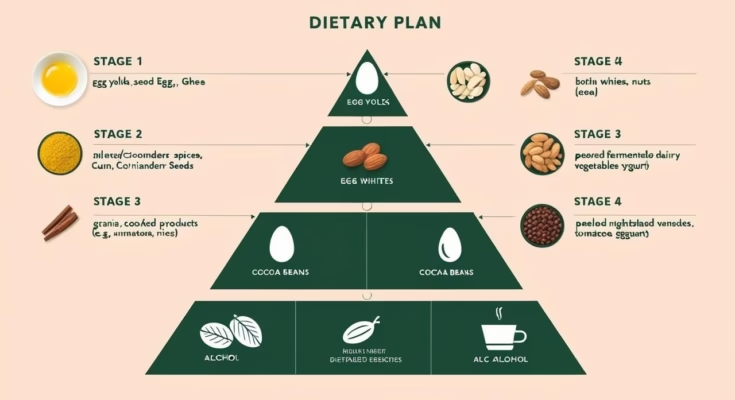The Autoimmune Protocol (AIP) diet is a powerful healing tool for people with autoimmune conditions. While the elimination phase gets a lot of attention, the AIP reintroduction phase is just as critical. Done right, it helps you discover your food triggers and broaden your diet again. But if you’re wondering exactly how to reintroduce foods on the AIP diet, you’re not alone — it’s a phase that’s often misunderstood.
Before you begin reintroducing foods on the AIP diet, it’s crucial to ensure you’ve completed the elimination phase properly and have a solid understanding of the foundation. If you’re still getting familiar with the AIP lifestyle, take a moment to read 6 Important Things to Know Before Starting the AIP Diet. This guide covers essential tips on food eliminations, mindset, preparation, and what to expect—helping you approach the reintroduction phase with greater clarity and success.
In this in-depth guide, we’ll walk through:
-
When and how to start reintroducing foods
-
The correct order of food reintroductions
-
How to track your body’s responses
-
What mistakes to avoid during the process
Let’s make your reintroduction phase successful, sustainable, and stress-free.
Why the AIP Reintroduction Phase Matters
The AIP diet has two main phases: elimination and reintroduction.
During the elimination phase, you remove inflammatory and potentially triggering foods — things like grains, dairy, legumes, nuts, seeds, nightshades, eggs, and more. The goal is to give your immune system a break and allow inflammation to calm down.
But you can’t stay in elimination forever.
That’s where reintroduction comes in. This phase allows you to:
-
Rebuild food freedom and reduce dietary restrictions
-
Identify personal food triggers
-
Expand your nutrient diversity by reintroducing foods that work for you
Skipping or rushing this phase means missing out on valuable data about your own body.
When Should You Start Reintroducing Foods?
Timing matters.
You want to begin reintroducing foods only after your symptoms have significantly improved. While there’s no universal timeline, most people are ready between 30 and 90 days after starting AIP.
🔍 Signs You’re Ready:
-
Reduced digestive issues
-
Improved energy levels
-
Better sleep and mood
-
Less joint pain, brain fog, or skin flares
If you’ve been on AIP for months without improvement, it’s worth revisiting your approach with a practitioner before starting reintroduction.
How to Reintroduce Foods on the AIP Diet (Step-by-Step)
Let’s break down exactly how to reintroduce foods on the AIP diet — carefully, systematically, and safely.
✅ Step 1: Choose the Right Food to Reintroduce
Not all foods are reintroduced equally. The AIP protocol organizes foods into four reintroduction stages, based on their likelihood of causing a reaction.
Start with Stage 1 foods, which are least likely to trigger symptoms.
AIP Reintroduction Stage 1 Examples:
-
Egg yolks (from pasture-raised eggs)
-
Ghee (clarified butter)
-
Legumes with edible pods (green beans, peas)
-
Seed-based spices (cumin, coriander)
Avoid jumping ahead to chocolate or grains too soon — your body needs time.
✅ Step 2: Follow the Structured Testing Process
Once you’ve selected a food, follow this three-day testing protocol:
Day 1 — Reintroduce Small Amounts
-
Take one small bite (e.g., 1 tsp ghee or 1/4 tsp of a spice).
-
Wait 15 minutes.
-
If no reaction, take a slightly larger amount (e.g., 1/2 tsp).
-
Wait 2–3 hours.
-
If still no symptoms, consume a full serving with your next meal.
Day 2 and 3 — Eliminate the Test Food Again
-
Don’t eat the test food again for 48–72 hours.
-
Watch for any delayed reactions.
✅ Step 3: Track Symptoms Closely
This phase is all about observing your body’s response.
Use a food and symptom journal to track:
-
What food you reintroduced
-
Quantity and time of day
-
Symptoms (digestive issues, headaches, fatigue, mood changes, skin reactions, joint pain, etc.)
-
Severity and timing of reactions
Even mild symptoms can indicate a sensitivity — especially if they repeat with more reintroductions.
✅ Step 4: Decide Whether to Keep the Food
After observing for 3–5 days:
-
No symptoms? Keep the food in your diet and move on after a few days.
-
Mild symptoms? Consider retesting in a few weeks.
-
Clear negative symptoms? Avoid the food and retest months later.
A failed reintroduction isn’t a setback — it’s data.
AIP Reintroduction Timeline: How Fast Should You Go?
The speed of reintroduction varies by individual.
Here are general guidelines:
| Reintroduction Pace | Description |
|---|---|
| Slow (1 food/week) | Ideal if you’re cautious or have multiple autoimmune conditions |
| Moderate (2 foods/week) | Good pace if symptoms are stable |
| Fast (1 food every 2 days) | Only if your immune system is very calm and you’ve had consistent results |
The more reactive your body is, the slower you should go.
Sample 4-Week AIP Reintroduction Plan
| Week | Reintroduced Food | Notes |
|---|---|---|
| Week 1 | Ghee | Start with 1 tsp, increase as tolerated |
| Week 2 | Egg yolks | Separate yolks from whites |
| Week 3 | Green peas | Lightly steamed, 1/4 cup |
| Week 4 | Almond butter (1 tsp) | Watch for delayed digestive issues |
After a successful month, you can move into Stage 2 foods like pasture-raised egg whites or macadamia nuts.
Common AIP Reintroduction Mistakes to Avoid
Reintroducing foods is tricky — here’s what to avoid if you want accurate results.
❌ 1. Reintroducing Too Many Foods at Once
If you test two or three foods in the same week and get symptoms, you won’t know which food caused the reaction.
❌ 2. Skipping the Waiting Period
Delayed food reactions are common in autoimmunity. If you don’t wait 2–3 days, you may miss subtle signs.
❌ 3. Not Tracking Symptoms
Memory is unreliable. Use a journal to spot patterns and reactions.
❌ 4. Starting Reintroduction Too Early
Your immune system must be in a calm state. Reintroducing while inflamed won’t give you valid results.
What to Do If a Food Causes a Reaction
If you react to a food, don’t panic.
Here’s what to do:
-
Remove the food immediately.
-
Support your body with nutrient-dense meals, bone broth, and extra rest.
-
Track the reaction in detail.
-
Try again in 1–3 months, if appropriate.
A failed reintroduction doesn’t mean “never”—it” means “not now.”
How to Reintroduce Trigger Foods Later
Some of the most common food triggers include:
-
Egg whites
-
Nightshades (like tomatoes and peppers)
-
Nuts and seeds
-
Dairy
When you’re ready to retest them:
-
Be extra cautious
-
Consider working with an AIP-certified coach or functional practitioner
-
Use healing tools (like digestive enzymes or gut support) as needed
Bonus Tips for a Smooth AIP Reintroduction
-
Stick to whole, simple foods — complex recipes hide reactions.
-
Try only one new food at a time — no mixed reintroductions.
-
Be patient with yourself — this isn’t a race.
-
Keep nutrient density high — don’t let reintroductions displace healing foods.
Frequently Asked Questions (FAQ)
How long does the AIP reintroduction phase last?
It depends on how many foods you reintroduce and how reactive you are. It can last from a few months to over a year.
What happens if I react to a food during reintroduction?
You should remove the food, let your symptoms settle, and try reintroducing it again in a few months.
Can I ever reintroduce gluten, dairy, or nightshades?
Some people can tolerate ghee, fermented dairy, or white rice eventually. Gluten is often best avoided long-term in autoimmune conditions.
Do I need to reintroduce all eliminated foods?
No. The goal is to reintroduce nutrient-dense, minimally processed foods — not everything you once ate. Use your body’s signals as a guide.
Is there a reintroduction food chart I can use?
Yes — many AIP websites offer printable reintroduction stage charts. You can also create a personalized checklist as you go.
Final Thoughts: You’re Not Meant to Eliminate Forever
The reintroduction phase is not the finish line — it’s the bridge to long-term food freedom. By going slow, tracking symptoms, and listening to your body, you’ll gain more than just a broader diet —you’ll gain confidence and clarity about what works for you.
Every food reintroduced successfully is a win for flexibility and nutrition.
You’ve already done the hard work of healing. Now it’s time to build a diet that’s personalized, sustainable, and joyful.


